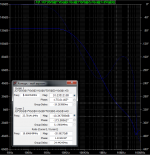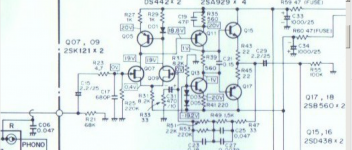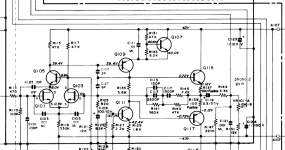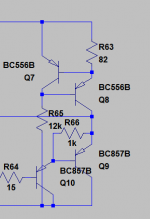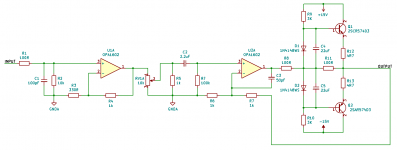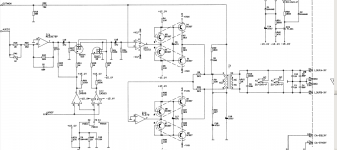And unity gain stable without any caps ?
Show us then.
I succumbed to the heat a bit, but really in the framework of decency.
All external compensation.
Aperiodic step response with 100ns rise/fall times.
Attachments
How would a discrete output stage be done?
I've attached a fragment from one of my LTspice sims. R64 comes from pin5 of AD744, the output (and feedback) comes from emitter of Q9.
for example the Topping A30 has an LM337D2 going to the output RCA's. Would that be considered a discrete output?
Isn't LM337 an IC regulator? Not at all discrete.
Also, can an OPA627 with a BUF634 be replaced with an AD744 for better noise, distortion while still using a discrete output to drive big loads like 300 ohm easily? I've been thinking about paralleling 4 of them but it's not exactly cost effective.
I'm lost with this question, sorry. An AD744 can only replace an OPA627 if the increased noise isn't an issue.
Attachments
Isn't LM337 an IC regulator? Not at all discrete.
I'm lost with this question, sorry. An AD744 can only replace an OPA627 if the increased noise isn't an issue.
What I'm trying to figure out is why would a regulator be placed on the output stage?
Also, what I was refering to with that question was, if I replace the AD744 with a OPA627 and some buffers, will it sound better? All assuming I keep the same output stage.
Thanks
Guys, if you don't mind me asking, what exactly is the question at this point?
How to make a discrete op-amp that beats the OPA627?
If that is the case, beat the OPA627 in what regard: Noise, power, distortion, precision, all the above?
Best, Sandro
How to make a discrete op-amp that beats the OPA627?
If that is the case, beat the OPA627 in what regard: Noise, power, distortion, precision, all the above?
Best, Sandro
Guys, if you don't mind me asking, what exactly is the question at this point?
How to make a discrete op-amp that beats the OPA627?
If that is the case, beat the OPA627 in what regard: Noise, power, distortion, precision, all the above?
Best, Sandro
The question started out with a discrete op amp solution that will beat out that particular chip, though some members here suggested to instead make a discrete output stage rather then a discrete op amp stage.
Hi Kdent, given this is your thread, the question is for you. You want to beat the OPA627, in what regard: Noise, power, distortion, precision, some of the above (specify) or all the above, other?
Best, Sandro
Best, Sandro
Last edited:
Sandrohv, in regards to your question, I would like to beat the output power of that chip, alongside the distortion. I would still want it to sound as good if not better then the OPA624. Specs are one thing but how it actually sounds is another
- Beat output power: Making a discrete output stage will help you with that.
- Beat the distortion: Making a discrete output stage may or not help you, since a large contributor of the distortion will be the front end op-amp of choice.
- Making it sound as good as the OPA624: Not sure how you plan to do that. Do you know what makes the OPA624 sound good? Better question, do you know what makes an op-amp (any op-amp) sound good?
You said "Specs are one thing but how it actually sounds is another", which translates to "specs don't determine how good it sounds."
By the way, how do you quantify how good the op-amp sounds, what unit do you use? SGU (Sound goodness units)?
Regards, Sandro
- Beat the distortion: Making a discrete output stage may or not help you, since a large contributor of the distortion will be the front end op-amp of choice.
- Making it sound as good as the OPA624: Not sure how you plan to do that. Do you know what makes the OPA624 sound good? Better question, do you know what makes an op-amp (any op-amp) sound good?
You said "Specs are one thing but how it actually sounds is another", which translates to "specs don't determine how good it sounds."
By the way, how do you quantify how good the op-amp sounds, what unit do you use? SGU (Sound goodness units)?
Regards, Sandro
Sandro, thanks for the breakdown. Maybe making a full discrete solution may be a little to complex for my abilities, therefor I was thinking maybe to use the OPA624, but in a way increase the power, say to drive 300 ohm headphones while still retaining the same sound. Can this be easily done? As I said before, paralleling the chips will increase output, but the cost of that will add up quick.
Thanks
Thanks
I just searched OPA624, and I can't find the datasheet. Can you post a link to the datasheet so I can take a look and help you? Or, you actually meant OPA627 and it was a typo.
Datasheet from TI: http://www.ti.com/lit/ds/symlink/opa627.pdf
EDIT: My apologies, I must have got the numbers mixed up in my head. My bad.
EDIT: My apologies, I must have got the numbers mixed up in my head. My bad.
Last edited:
Hello everyone, I posted this in another channel but got recommended to post it here:
I recently discovered these discrete op amps. Off the top of my head Sparkos Labs and Burson Audio makes some pretty nice ones. Would any of you have some suggestions on schematics to make one of my own? Preferably to compete with higher end IC based op amps such as Burr Browns 627/637. Thanks!
If you are going to design a discrete opamp it's worth considering from the
outset what it is you want to achieve and also what properties that are not
available from conventional IC opamps.
For example in Pro Audio there are many pieces of outboard gear that
integrate Neve style, discrete opamps. These are low OLG, single ended,
class A arrangements that have a certain sound that is very musical but not
necessarily ruthlessly transparent.
OTOH, if you want to go the super transparent path, three things that can differentiate your design from a chip opamp are:
a/ IP stage with degenerated IP devices bypassed with inductors AKA Samuel Groners and Jensen 990.
b/ 2 pole compensation networks. I think Groners and Sparkos have such
c/ High current, class A OP stage.
It's also worth considering what applications you will be using it in.
If the application was I-V for DAC etc, then common mode distortion is not
a consideration. If higher impedance applications are in your crosshairs, a
following cascoded IP stage can greatly reduce CM distortion and enhance performance in hi Z circuits.
A few things to think about before you start throwing time at a design
which may not be that well suited for your applications.
cheers
TCD
What I'm trying to figure out is why would a regulator be placed on the output stage?
Assuming that we identified it correctly and it really was an LM337 then I think it could have been used as a current source to bias a single-ended classA output transistor.
Also, what I was refering to with that question was, if I replace the AD744 with a OPA627 and some buffers, will it sound better? All assuming I keep the same output stage.
Very hard to answer that, if pushed I'd guess the answer would be 'no'. SQ is more a function of power supplies - especially keeping classAB output stages from contaminating the supplies of earlier stages - than it is of particular opamp types.
Assuming that we identified it correctly and it really was an LM337 then I think it could have been used as a current source to bias a single-ended classA output transistor.
Very hard to answer that, if pushed I'd guess the answer would be 'no'. SQ is more a function of power supplies - especially keeping classAB output stages from contaminating the supplies of earlier stages - than it is of particular opamp types.
I'd guess it's a mistake, Topping uses ICs for almost everything that I've ever seen.
If you want to build some Discretoop amps up I have done both SMD and thru hole versions.
The topology is quite conventional - with a class A output.
The link below is to the all through hole version. I did this because. The SMD version fits above a DIL socket.
Don't ask me to wax lyrical about them. I think they are cool and measure brilliantly. They are though a fair amount of soldering to get a handful of op amps!!!
Both are drop in for standard dual op amps noting theneedto be aware of differing compensation/ slew rate assumptions of designers.
I had a stack of the pcb's made and have a load of unused unloaded boards. If you want to try them out drop me a mail and I will shoot you some.
Discrete Operational Amplifier (DOA) Thru Hole - STEAMPUNK version!
The topology is quite conventional - with a class A output.
The link below is to the all through hole version. I did this because. The SMD version fits above a DIL socket.
Don't ask me to wax lyrical about them. I think they are cool and measure brilliantly. They are though a fair amount of soldering to get a handful of op amps!!!
Both are drop in for standard dual op amps noting theneedto be aware of differing compensation/ slew rate assumptions of designers.
I had a stack of the pcb's made and have a load of unused unloaded boards. If you want to try them out drop me a mail and I will shoot you some.
Discrete Operational Amplifier (DOA) Thru Hole - STEAMPUNK version!
Boosting opamp power output is indeed possible. So called composite amplifier topology is very interesting.How would a discrete output stage be done? For example the Topping A30 has an LM337D2 going to the output RCA's. Would that be considered a discrete output?
Also, can an OPA627 with a BUF634 be replaced with an AD744 for better noise, distortion while still using a discrete output to drive big loads like 300 ohm easily? I've been thinking about paralleling 4 of them but it's not exactly cost effective.
Thanks guys
You can have a look at pages 62-66 in Op Amp Applications Handbook by Walt Jung. He describes this kind of circuits, even including usage of AD744 which you mentioned.
Today we have even better ICs suited for that role. BUF634A or LME49600 are high speed buffers designed to work inside of feedback loop of an opamp, boosting its current capabilties.
Also you can check my project incorporating OPA1602 and TPA6120A2 - LINK.
U2 can be replaced with discrete amplifier. I've played with circuit as in attachement but later decided to stick with ICs.
Discrete transistors means more parts, more complex PCB and higher costs. Here's another example - Class A output stage in feedback loop of LM4562.
Paralleling opamps is another viable approach. Schiit Magni Heresy or HPA part of RME ADI-2 DAC uses paralled OPA1688. Very popular O2 also uses paralled opamps at output stage. Composite amplifiers should yeld slightly better performance, but they are much harder to design however.
There is also very clever circuit by Shaq888 which uses both nested feedback and paralled opamps at output stage - "The Crocodile"
Attachments
For me, I want a discrete op-amp with spec:
1. Unity gain stable with minimum slew rate 15V/uS.
2. THD maximum 0.01% at 20 - 20kHz, at any level below clipping with 600 Ohm load.
3. Harmonic profile is monotonic.
4. PSRR minimum 80 dB at 20kHz.
5. Input noise voltage maximum 3nV/sqrt(Hz) at 1kHz.
DC precision is not important. Total power dissipation is not important, as long as the transistor output can survive without heatsink.
So, I can replace of almost any op-amp with input level around line level.
1. Unity gain stable with minimum slew rate 15V/uS.
2. THD maximum 0.01% at 20 - 20kHz, at any level below clipping with 600 Ohm load.
3. Harmonic profile is monotonic.
4. PSRR minimum 80 dB at 20kHz.
5. Input noise voltage maximum 3nV/sqrt(Hz) at 1kHz.
DC precision is not important. Total power dissipation is not important, as long as the transistor output can survive without heatsink.
So, I can replace of almost any op-amp with input level around line level.
Hi Bimo, what supplies do you need?
With those specs, you can buy quite a few IC op-amps, unless you want high supplies (more than +/- 15V).
600ohms is not hard to drive with low THD with an IC output stage.
This one from TI meets most of your specs: See figure 8 for distortion.
http://www.ti.com/lit/ds/symlink/opa1612.pdf
It does not meet PSRR though, it is 70dB at 20KHz.
Best, Sandro
With those specs, you can buy quite a few IC op-amps, unless you want high supplies (more than +/- 15V).
600ohms is not hard to drive with low THD with an IC output stage.
This one from TI meets most of your specs: See figure 8 for distortion.
http://www.ti.com/lit/ds/symlink/opa1612.pdf
It does not meet PSRR though, it is 70dB at 20KHz.
Best, Sandro
Last edited:
- Home
- Amplifiers
- Solid State
- Discrete op amp

